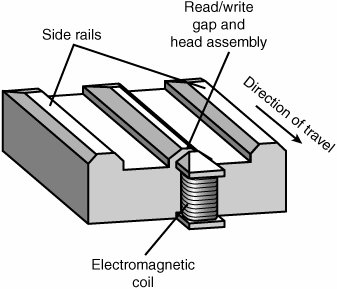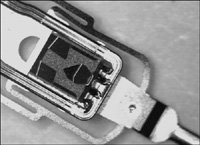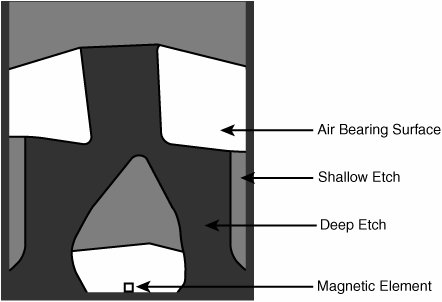Head Sliders
| The term slider is used to describe the body of material that supports the actual drive head itself. The slider is what actually floats or slides over the surface of the disk, carrying the head at the correct distance from the medium for reading and writing. Older sliders resemble a trimaran, with two outboard pods that float along the surface of the disk media and a central "hull" portion that actually carries the head and read/write gap. Figure 8.7 shows a typical mini slider. Note that the actual head, with the read/write gap, is on the trailing end of the slider. Figure 8.7. The underside of a typical head mini slider. The trend toward smaller and smaller form factor drives has forced sliders to become smaller as well. The typical Mini-Winchester slider design was about 4mm x 3.2mm x 0.86mm in size. Most head manufacturers have since shifted to smaller Micro, Nano, Pico, or Femto sliders. The Femto sliders in use today are extremely smallabout the size of the ball in the tip of a ballpoint pen. Pico and Femto sliders are assembled by using flex interconnect cable (FIC) and chip on ceramic (COC) technology that enables the process to be completely automated. Table 8.1 shows the characteristics of the various types of sliders used in hard disk drives.
Smaller sliders reduce the mass carried at the end of the head actuator arms, which provides increased acceleration and deceleration leading to faster seek times. The smaller sliders also require less surface area, allowing the head to track closer to the outer and inner diameters, thus increasing the usable area of the disk platters. Further, the smaller slider contact area reduces the slight wear on the platter surface that occurs during normal startup and spindown of the drive platters. Figure 8.8 shows a magnified photo of a Femto slider mounted on the head gimbal assembly, which is on the end of the head actuator arm. Figure 8.8. Magnified head gimbal assembly featuring a Femto slider. Photo courtesy Hitachi Global Storage Technologies. The newer slider designs also have specially modified surface patterns that are designed to maintain the same floating height above the disk surface, whether the slider is positioned above the inner or outer cylinders. Conventional sliders would increase or decrease their floating heights considerably according to the velocity of the disk surface traveling beneath them. Above the outer cylinders, the velocity and floating height would be higher. This arrangement is undesirable in newer drives that use zoned bit recording, in which the bit density is the same on all the cylinders. When the bit density is uniform throughout the drive, the head floating height should also be relatively constant for maximum performance. Special textured surface patterns and manufacturing techniques enable the sliders to float at a much more consistent height, making them ideal for zoned bit recording drives. For more information on zoned recording, see the section "Disk Formatting" in Chapter 9. A typical Femto air-bearing slider surface design is shown in Figure 8.9. Figure 8.9. Femto air-bearing slider surface design. A Femto slider has three distinct areas with complex shapes designed to achieve a consistent head-to-disk floating height across the disk as well as minimal height loss under high-altitude (low-pressure) conditions. The shallow etch area creates a stepped air inlet allowing airflow to create a positive pressure under the air-bearing surface that lifts the slider away from the disk. The deep etch area creates an opposite negative pressure pocket that simultaneously pulls the slider closer to the disk surface. The combination of positive and negative pressures is designed to balance the force of the suspension arm pushing the slider toward the disk, while keeping the slider at the desired floating height away from the disk surface. The balance of positive and negative pressures stabilizes and reduces the floating height variations commonly found in older slider designs. The first drive using the Femto slider design was the Hitachi 7K60 2 1/2" drive released in May 2003. Most of the higher-capacity drives on the market today use this design. | ||||||||||||||||||||||||||||||||||||||||||||||||||||||||
EAN: 2147483647
Pages: 283


